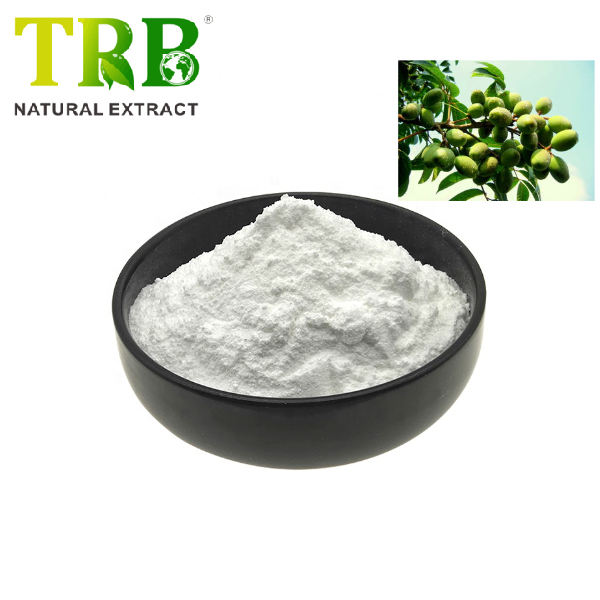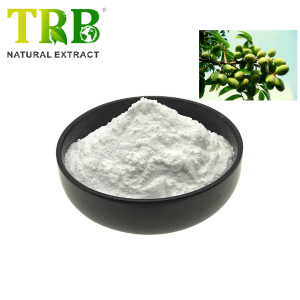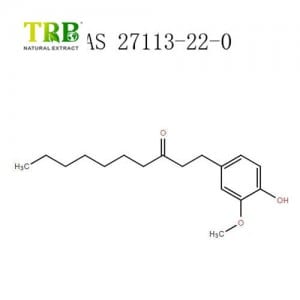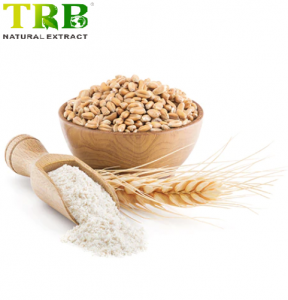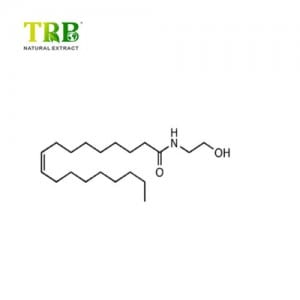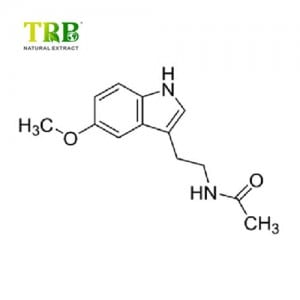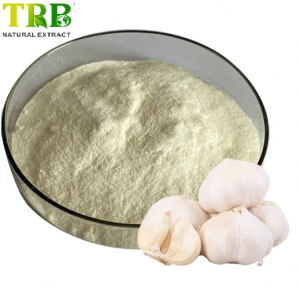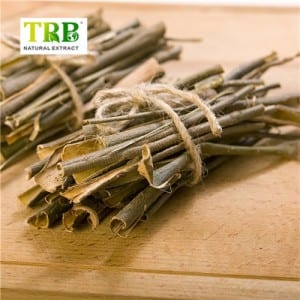Oleanolic acid eyiti o jẹ pentacyclic triterpenoids mẹta ti o ya sọtọ lati awọn irugbin Gentianaceae ti Swertia mileensis gbogbo koriko tabi eso privet, pẹlu ara ọfẹ ati awọn glycosides ni ọpọlọpọ awọn irugbin.Oleanolic acid ni ọpọlọpọ awọn ohun ọgbin, ati akoonu apapọ jẹ 0.2% - 2%.Cucurbitaceae akoonu giga jẹ 1.5% ~ hunchback isalẹ 2%, akoonu eso privet ti 0.6% ~ 0.7% .Oleanolic acid jẹ iru pentacyclic triterpenoid yellow ti o ya sọtọ lati eso ti iwin Asteraceae, Syzygium sylvestris, tabi Ligustrum lucid.O jẹ adjuvant arun ẹdọ ati ti a lo ni ile-iwosan fun ikolu ti itọju ailera.Jedojedo jaundice nla ni awọn ipa ti o han gbangba lori idinku alanine aminotransferase ati yellowing.Oolic acid jẹ pentacyclic triterpenoids ti o ya sọtọ lati eso swertia chinensis tabi fructus ligustris lati inu ọgbin gentianaceae.Oleanolic acid wa ni ibigbogbo ninu awọn irugbin, pẹlu akoonu gbogbogbo ti 0.2% ~ 2% [1].Awọn akoonu ti isalẹ ti calabash jẹ 1.5% ~ 2%, ati akoonu ti eso ti fructus ligustris jẹ 0.6% ~ 0.7%.Oleanolic acid jẹ kirisita acicular funfun (ethanol), olfato ati aibikita.Iduroṣinṣin si awọn acids ati awọn ipilẹ.Yiyọ ojuami ti 308 ~ 310 ℃, [alpha] 20 d + 73.3 ° (c = 0.15, chloroform, insoluble ninu omi, tiotuka ni kẹmika, ethanol, ethyl ether, acetone ati chloroform.Oleanolic acid ni a nipa ti sẹlẹ ni triterpenoid, ni opolopo pin). ninu ounjẹ ati awọn ohun ọgbin oogun, ti o ni ibatan si acid betulinic O le rii ni Phytolacca americana (pokeweed Amẹrika), ati Syzygium spp, ata ilẹ, ati bẹbẹ lọ Ko jẹ majele ti, hepatoprotective, ati ṣafihan awọn ohun-ini antitumor ati antiviral.
Oleanolic acid ni a rii lati ṣe afihan iṣẹ-ṣiṣe anti-HIV ti o lagbara, a ti lo apopọ betulinic acid ti o ni ibatan lati ṣẹda oogun inhibitor maturation iṣowo akọkọ.A kọkọ ṣe iwadi ati ya sọtọ lati awọn irugbin pupọ, pẹlu Rosa woodsii (awọn ewe), Prosopis glandulosa (awọn ewe ati eka igi), Phordendron juniperinum (gbogbo ọgbin), Syzygium claviflorum (awọn ewe), Hyptis capitata (gbogbo ọgbin), ati Ternstromia gymnanthera (erial) apakan).Miiran Syzygium eya pẹlu Java apple (Syzygium samarangense) ati soke apples ni o.
Orukọ ọja: Oleanolic Acid98%
Ni pato: 98% nipasẹ HPLC
Orisun Botanic: Olea Europea Extract
Orukọ Kemikali: (3β) -3-Hydroxyolean-12-en-28-oic acid
CAS Bẹẹkọ:508-02-1
Apa Lo: Ewe
Awọ: Funfun lulú pẹlu õrùn abuda ati itọwo
Ipo GMO: Ọfẹ GMO
Iṣakojọpọ: ni 25kgs okun ilu
Ibi ipamọ: Jeki apoti ti a ko ṣii ni itura, aye gbigbẹ, Jeki kuro ni ina to lagbara
Igbesi aye selifu: awọn oṣu 24 lati ọjọ iṣelọpọ
Kinioleanolic acid?
Oleanolic acid (OA), a adayeba hydroxyl pentacyclic triterpenoid acid (HPTA) iru si betulinic acid, ursolic acid;o ni awọn anfani bi antibacterial, egboogi-iredodo, awọn iṣẹ antitumor.

Nibo ni o ti le riioleanolic acid?
Oleanolic acid ti lo ni aṣa fun itọju awọn aarun pupọ, o le rii ni ounjẹ ati awọn irugbin lọpọlọpọ.
Diẹ ninu awọn eso bi apples, pomegranate, lẹmọọn, bilberries, olifi ni oleanolic acid paapaa.

| Orukọ Ewebe | Oleanolic acid akoonu | Ọna idanwo |
| Ligustrum lucidum Ait | 0.8028% | HPLC |
| Verbena Officinalis L | 0.071% -0.086% | HPLC |
| Prunella vulgaris L | 3.47% -4.46% | HPLC |
| Hemsley Chinensis Cogn. | 1.5% ~ 2% | HPLC |
Lọwọlọwọ, Chinese ewekoHemsley Chinensis Cogntun jẹ ohun elo aise ti iṣowo julọ fun yiyọ oleanolic acid.
Hemsley Chinensis Cogn.Ifaara
Hemsleya chinensis Cogn.jẹ ewe gígun ọ̀tọ̀ọ̀tọ̀, ó tún jẹ́ oogun Kannada ìbílẹ̀.
Ìdílé: Cucurbitaceae
Tribus: Gomphogyneae
Ipilẹṣẹ: Hemsleya
Eya: H. amabilis
Ewebe naa ti pin ni awọn agbegbe Guangxi, Sichuan, Guizhou, Yunnan, Hubei, ati bẹbẹ lọ ti a bi ni eti igbo ati awọn igi afonifoji ni giga ti o to awọn mita 2,000.
Awọn eroja ti nṣiṣe lọwọ: ni Hemslolide Mal, Ma3, H1;Chikusetsusaponin-Iva;dihydro cucurbitacin F-25-acetate;dilydrocucurbitacin F;oleanolic acid-beta-Hlucosyloleanolate;Hemsamabilinin A;Cu-curbitacinⅡb-2-beta-D-glucopyranoside.
Awọn iye oogun:
Hemsleya chinensis Cogn.jẹ akọkọ fun detoxification, sterilization, egboogi-iredodo, okunkun ikun ati imukuro irora.Lọwọlọwọ, awọn ayokuro lulú wa, tabi awọn igbaradi agbo gẹgẹbi awọn capsules, awọn tabulẹti, awọn oogun ikun ati inu, ati bẹbẹ lọ, eyiti a lo ni lilo pupọ ni adaṣe ile-iwosan.

Iyọkuro ti Oleanolic acid latiHemsleya Chinensis Cogn.

Awọn agbekalẹ ti o ni Oleanolic acid ninu awọn afikun Ounjẹ
A rii pe oleanolic acid ti a lo ninu awọn afikun ilera ni akọkọ wa lati oriṣi awọn ohun elo ọgbin mẹta: jade ewe Loquat, jade Hemsley Chinensis, ati jade basil mimọ.
- Mimọ Basil lulú (ewe) (0.4% Ursolic acid ati Oleanolic acid, 2.0 mg)
- Mimọ Basil supercritical CO2 jade (ewe) (Ocimum tenuiflorum Linn.) (2.5% Ursolic acid ati Oleanolic acid, 1.5 mg)
- Loquat Extract (eso) (ti n pese Ursolic acid, Oleanolic Acid) (Iwọn deede si Ursolic acid Fun Sisin 125mg)

Oleanolic acid VS Ursolic acid
Oleanolic acid (OA) ati ursolic acid (UA) jẹ awọn triterpenoids adayeba ti o ni ilana kemikali ti o jọra.
Awọn agbo ogun triterpenoids wọnyi ni a mọ lati wa ninu awọn ewe oogun ati awọn ounjẹ.
Wọn ni ọpọlọpọ awọn ohun-ini elegbogi ti o wọpọ: hepatoprotective, anti-inflammatory, antimicrobial, hypoglycemic, antimutagenic, anti-HIV, antioxidant, and antifertility activities.

Iyatọ OA ati UA:
| Orukọ ọja | Oleanolic acid | Ursolic acid |
| CAS RARA. | 508-02-1 | 77-52-1 |
| Pentacyclic triterpenes | β-Amyrin | α-Amyrin |
| Awọn orisun ewebe | Ewe Loquat, Basil Mimọ, Rosemary, Ewe olifi.etc. | |
| Awọn pato | 40%,98% lulú | 15%,25%,50%,98% lulú |
| Irisi (awọ ati oorun) | 40% ina yellow98% funfun powderodorless | 15% -50% brown-ofeefee tabi yellow98% funfun powderCharacteristic |
| Iyatọ | IR: (1355 ~ 1392cm-1) awọn oke meji (1245 ~ 1330cm-1) awọn oke mẹtaNMR: δ (C12)122.1,δ(C13) 143.4 | (1355-1392cm-1) awọn oke mẹta (1245 ~ 1330cm-1) awọn oke mẹta (C12)125.5,δ(C13) 138.0 |
| Awọn itọsẹ | Oleanolic soda saltOleanolic acid fosifeti disodium iyọ3-oxo oleanolic acid bardoxolone methyl (CDDO-Me) | Iyọ iṣu soda Ursolic ati dicarboxylic acid rẹ awọn itọsẹ idaji esterUrsolic acid ketene awọn itọsẹ3-carbon ursolic acid 3-acetoxyursolic acid |
| Anticancer ti o pọju | UA jẹ olokiki diẹ sii ju OA lọ. | |
Awọn iṣẹ iṣe ti Ẹjẹ ti Oleanolic Acid
-
Awọn ipa Anti-Tumour/Agbogun ti Akàn
Ipa idilọwọ ti oleanolic acid lori carcinoma hepatocellular nipasẹ ERK-p53-mediated cell cycle arrest ati mitochondrial-based apoptosis
- nipasẹ Xin Wang, Hua Bai, ati bẹbẹ lọ Awọn oniwadi
OA ṣe afihan ipa inhibitory lori HCC nipasẹ ifisilẹ ti apoptosis ati imudani ọmọ sẹẹli mejeeji ni awọn èèmọ gbigbe ati ninu awọn sẹẹli HepG2.
Apoptosis ti OA fa nipasẹ ọna mitochondrial, jẹri nipasẹ idinamọ Akt/mammalian afojusun ti ipa ọna rapamycin.
OA ti mu G2/M cell ọmọ imuni nipasẹ p21-ilaja isalẹ-ilana ti cyclin B1/cdc2.
OA ṣe afihan awọn iṣẹ antitumor pataki ni HCC ni vivo ati awọn awoṣe in vitro.Awọn data wọnyi pese oye tuntun sinu awọn ilana ti o wa labẹ ipa antitumor ti OA.
Ni afikun, iwadii fihan pe OA ati itọsẹ rẹ Oleanolic acid methyl ester tun ni awọn ipa lori akàn igbaya, akàn ẹdọfóró, akàn àpòòtọ, akàn cervical, awọn sẹẹli alakan pancreatic…

-
Iṣẹ iṣe Antimicrobial
OA nireti lati ni iṣẹ ṣiṣe antimicrobial lodi si ọpọlọpọ awọn aarun ajakalẹ-arun nitori pe o ṣe ipa pataki ni igbejako awọn ọlọjẹ ninu awọn irugbin.
OA ṣe afihan iṣẹ ṣiṣe iwọntunwọnsi lodi si Staphylococcus aureus ati Bacillus Thuringiensis ni 62.5 µg/mL ati Escherichia coli, Salmonella Enterica, ati Shigella dysenteriae ni 31.2 µg/mL ifọkansi inhibitory ti o kere ju (MIC).
-
Agbara Hepatoprotective
Ọkan ninu ohun akiyesi bioactivities ti OA ni aabo ti ẹdọ lodi si majele ti ati ki o ti wa ni lo Lọwọlọwọ bi ohun lori awọn ẹdọ-oloro counter ni China.
Ninu awọn eku Wistar albino, OA lati Flaveria Trinervia ni a lo ati pe o ni ipa aabo pataki lori majele ẹdọ ti o fa ethanol nipa mimu-pada sipo awọn ipele hepatotoxic omi ara hepatotoxic.Iwadi yii daba agbara antioxidant ti OA bi ẹrọ miiran ti o ṣeeṣe ti agbara hepatoprotective rẹ.
Oleanolic acid ati awọn itọsẹ rẹ

Awọn Idanwo Isẹgun Oleanolic Acid
Oleanolic acid (orisun lati olifi), o wa nipa awọn idanwo ile-iwosan 500 ti o forukọsilẹ, fihan pe o ni awọn ipa anfani ni awọn idanwo ile-iwosan lori arun kidinrin onibaje, àtọgbẹ mellitus iru 2, ati diẹ ninu awọn ipo iredodo bii arthritis.
Awọn itọsẹ ti o gbajumọ julọ ni awọn idanwo ile-iwosan jẹ bardoxolone methyl (CDDO-Me).CDDO-Me ni a ṣe ayẹwo ni awọn biopsies tumo, ati pe o le ni ipa kan ninu itọju ti arun kidinrin onibaje, o ti ṣe ayẹwo lọwọlọwọ ni awọn ipa lori haipatensonu.
Iwọn Pharmacopoeia Kannada ti Oleanolic Acid
| Orukọ ọja | Oleanolic acid |
| Idanimọ | (1) Mu 30mg ti ọja yii, fi sinu tube idanwo, fi 3ml ti chloroform kun lati tu, fi omi sulfuric acid meji silė, gbọn fun iṣẹju 5, Layer chloroform jẹ eleyi ti-pupa. |
| (2) Mu nipa 20mg ti ọja yii, ṣafikun 1ml ti acetic anhydride, tu pẹlu ooru diẹ, ṣafikun sulfuric acid si awọ eleyi ti, ki o ṣokunkun lẹhin gbigbe. | |
| (3) Mu nipa 10mg ti ọja yi, fi vanillin glacial acetic acid ojutu (mu vanillin 0.5g, fi 10ml ti glacial acetic acid lati tu, ti o jẹ) 0.2ml, fi 0.8ml ti perchloric acid, ati ooru o fun orisirisi awọn iṣẹju. ninu omi wẹ.Fuchsia, ṣafikun 2ml ti ethyl acetate, eleyi ti-pupa ni tituka ni ethyl acetate, ti a gbe laisi discoloration. | |
| (4) Apọju gbigba infurarẹẹdi ti ọja yii yẹ ki o wa ni ibamu pẹlu iwọn iṣakoso. | |
| Ipinnu ti assay | Mu 0.15g ọja yii, ṣe iwọn rẹ ni deede, ṣafikun 30ml ti ethanol, gbọn, gbona ni iwẹ omi gbona lati tu, jẹ ki o tutu si iwọn otutu, ṣafikun 3 silė ti ojutu itọka phenolphthalein, ṣe ojutu potasiomu hydroxide pẹlu ethanol ( 0.05mol/L) Titrate lẹsẹkẹsẹ ati atunse fun idanwo òfo.Potasiomu hydroxide ojutu (0.05 mol/L) fun 1 milimita ti ethanol ni ibamu si 22.84 miligiramu ti C.30H48O3. |
Oleanolic acid ṣe iṣeduro iwọn lilo
Gẹgẹbi Standard Pharmacopoeia Kannada, iwọn lilo Oleanolic acid Oral jẹ 20 ~ 80mg fun akoko kan, 60 ~ 240mg fun ọjọ kan.
Oleanolic acid awọn ipa ẹgbẹ
Oleanolic acid ti a lo bi oogun hepatoprotective lori counter (OTC) fun ewadun ni Ilu China.
Ti o ba jẹ iwọn apọju tabi ti ko tọ, nọmba kekere ti awọn alaisan ni ẹnu gbigbẹ, gbuuru, aibalẹ inu oke, ati pe o le parẹ lẹhin itọju aami aisan.
Jọwọ kan si alagbawo rẹ tabi oloogun ṣaaju lilo ọja yii.
Iṣẹ:
1.Oleanolic acid jẹ jo ti kii-majele ti, antitumor, ati hepatoprotective, bi daradara bi ifihan antiviral-ini.
2.Oleanolic acid ni a ri lati ṣe afihan iṣẹ-ṣiṣe anti-HIV ti o lagbara.
3.Oleanolic acid jẹ aabo pataki ti awọn sẹẹli lodi si aapọn oxidative ati electrophile.
4.Oleanolic acid ni o ni nla ipa lori trating kokoro jedojedo, ńlá icteric jedojedo ati onibaje jedojedo.
Ohun elo:
1. Ti a lo ni aaye ounjẹ, o le ṣe bi awọn ohun elo aise ti tii lati dinku phlegm;
2. Ti a lo ni aaye oogun, o di oogun egboogi-akàn tuntun pẹlu majele kekere;
3. Ti a lo ni aaye ikunra, o le mu ki iṣan ẹjẹ pọ si ati yọ ohun mimu kuro.
| Alaye siwaju sii ti TRB | ||
| Ijẹrisi ilana | ||
| USFDA,CEP,KOSHER HALAL GMP ISO Awọn iwe-ẹri | ||
| Didara ti o gbẹkẹle | ||
| O fẹrẹ to ọdun 20, okeere awọn orilẹ-ede 40 ati awọn agbegbe, diẹ sii ju awọn ipele 2000 ti a ṣe nipasẹ TRB ko ni awọn iṣoro didara eyikeyi, ilana isọdọmọ alailẹgbẹ, aimọ ati iṣakoso mimọ pade USP, EP ati CP | ||
| Okeerẹ Didara System | ||
|
| ▲ Eto idaniloju Didara | √ |
| ▲ Iṣakoso iwe | √ | |
| ▲ Eto Afọwọsi | √ | |
| ▲ Eto Ikẹkọ | √ | |
| ▲ Ilana iṣayẹwo inu inu | √ | |
| ▲ Suppler Audit System | √ | |
| ▲ Eto Ohun elo Ohun elo | √ | |
| ▲ Eto Iṣakoso Ohun elo | √ | |
| ▲ Eto Iṣakoso iṣelọpọ | √ | |
| ▲ Packaging Labeling System | √ | |
| ▲ Eto Iṣakoso yàrá | √ | |
| ▲ Eto Afọwọsi Imudaniloju | √ | |
| ▲ Regulatory Affairs System | √ | |
| Ṣakoso Gbogbo Awọn orisun ati Awọn ilana | ||
| Ti ṣakoso ni pipe gbogbo awọn ohun elo aise, awọn ẹya ẹrọ ati awọn ohun elo iṣakojọpọ.Awọn ohun elo aise ti o fẹ ati awọn ẹya ẹrọ ati olupese awọn ohun elo apoti pẹlu nọmba DMF AMẸRIKA.Ọpọlọpọ awọn olupese ohun elo aise bi idaniloju ipese. | ||
| Awọn ile-iṣẹ ifowosowopo ti o lagbara lati ṣe atilẹyin | ||
| Institute of Botany/Ile-ẹkọ ti microbiology/Academy of Science and Technology/University | ||
